- Home
- About Us
- Products
-
Heat-Pump Dehumidifier DeAir
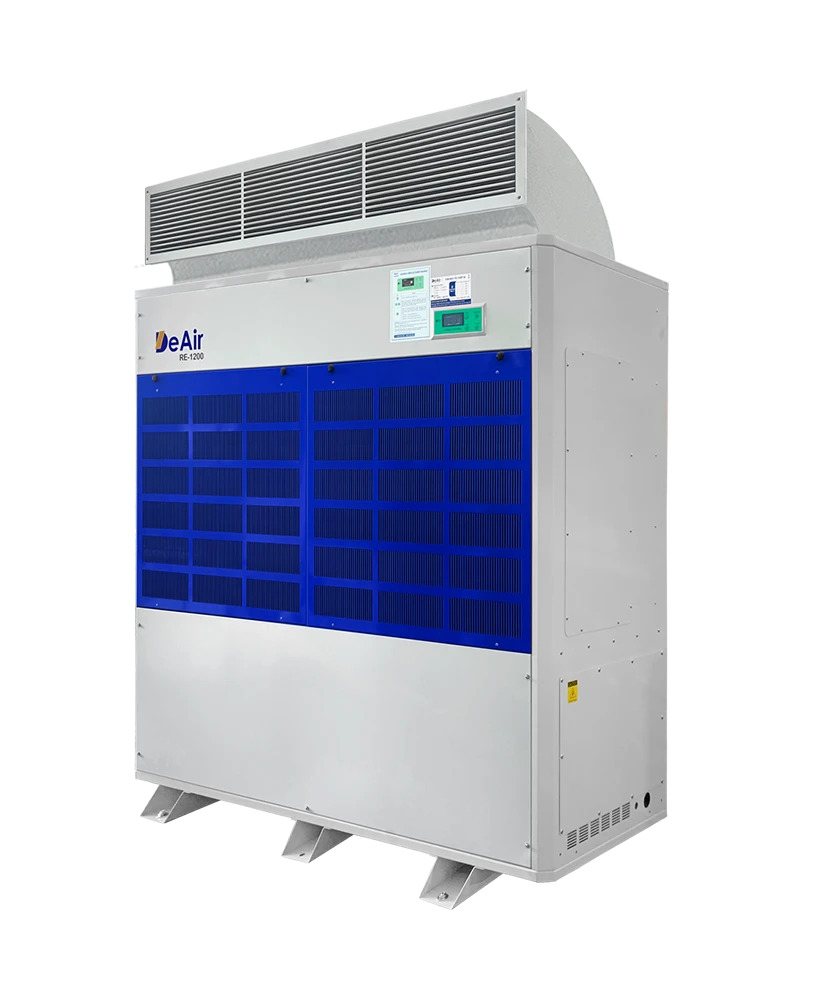 DeAir.RE
DeAir.RE -
Heat-Pump Dryer DeAir.RE-H
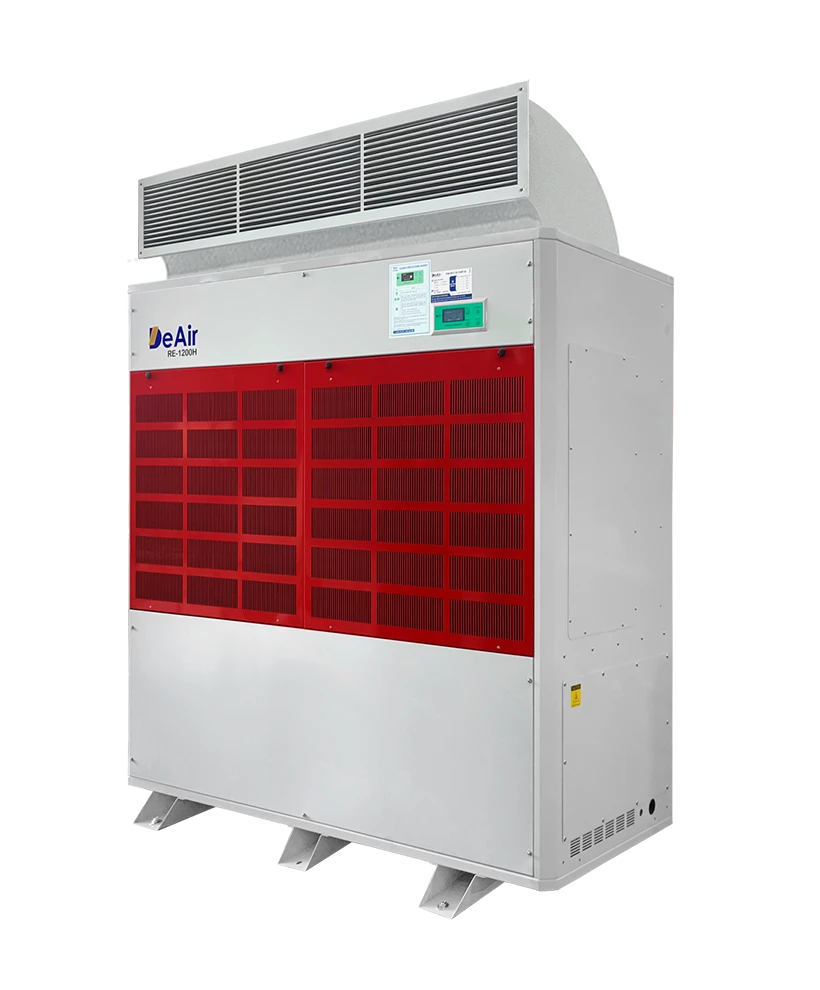 DeAir.RE-H
DeAir.RE-H -
Heat-Pump Stainless Steel Dehumidifier
 DeAir.RE-INOX
DeAir.RE-INOX -
Heat-Pump Isothermal Dehumidifier DeAir.CRE
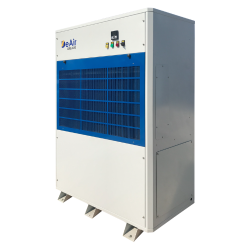 DeAir.CRE
DeAir.CRE -
Dezenno Dehumidifier
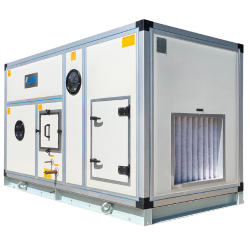 Dezenno
Dezenno -
Heat-Pump Ceiling Mounted Dehumidifier DeAir
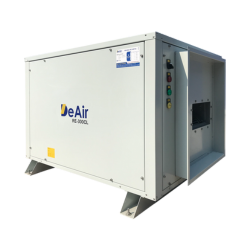 DeAir.RE-CL
DeAir.RE-CL -
Dehumidifier Olmas
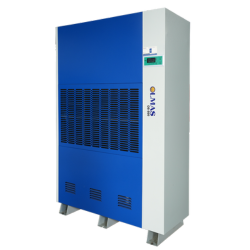 Olmas-OS
Olmas-OS -
Industrial Humidifier DeAir
 DeAir.HM
DeAir.HM -
Heat-Pump Dryer Daxwell
 Daxwell
Daxwell -
Electric Duct Heater DeAir
 DeAir.Heat
DeAir.Heat -
Air Handling Unit Dezenno.MAX
 AHU
AHU
-
- Services
- Projects
- Warranty – Maintenance
- News
- Contact
Dehumidifiers for Laboratories: Comprehensive Humidity Control Solutions
28/05/2025
In modern scientific and industrial environments, humidity control in laboratories is extremely important. High air humidity, especially during the rainy season, can damage precision instruments, indirectly affecting the efficiency and results of experiments. A dehumidifier for laboratories is the optimal solution to maintain an ideal environment. This article will delve into the importance of humidity control, the standards to comply with, and introduce effective dehumidifiers for laboratories.

The Importance of Humidity Control in Laboratories
Laboratories are special environments that require strict control of temperature and humidity to ensure the accuracy of experiments, and the preservation of equipment, chemicals, and specimens. Changes in temperature and humidity can affect the results of experiments and research.
Why do laboratories need strict humidity control?
- Impact on equipment: High humidity causes corrosion, rust, and reduces equipment lifespan. Conversely, low humidity creates static electricity, affecting electronic devices. For example, in electronic calibration labs, high humidity oxidizes metal connectors, causing errors in resistance measurement. For load cells, changes in ambient temperature will cause changes in sensitivity. In dry air (below 20%), electronic devices are susceptible to static electricity damage. Most manufactured equipment has environmental condition requirements to operate with maximum accuracy.
- Impact on materials and specimens: Many materials such as paper, wood, and biological samples easily absorb or release moisture, leading to changes in properties and weight. High humidity creates favorable conditions for bacteria and mold to grow, harming specimens and affecting human health. In pharmaceutical labs, humidity above 60% causes tablets to absorb moisture, deform their structure, and affect disintegration test results.
- Impact on experiment results: Temperature and humidity can change the speed and direction of reactions in experiments. Excessive humidity can lead to inaccurate readings on measuring devices. Chemical and biological reactions are highly sensitive to changes in laboratory environmental conditions.

Regulations and Ideal Humidity Conditions in Laboratories
Compliance with temperature and humidity in laboratories is mandatory. According to general standards, humidity in laboratories typically ranges from 40%- 70%. The most ideal environment is considered to have a relative humidity (RH) of 30% to 50% and a temperature ranging from 20 to 25 °C.
Depending on the type of laboratory, temperature and humidity regulations will vary:
- Temperature and humidity stable room: approximately 20°C (68°F to 77°F).
- Laboratory and inspection room: approximately 20°C ± 5°C.
- Temperature balance room: approximately 20°C ± 3°C.
- Sample room: Below 32°C.
Specific requirements for each type of laboratory include:
- Chemical and Physics Laboratories: Humidity 40-60%, Temperature 20-25°C.
- Electrical and Electronics Laboratories: Humidity 40-70%, Temperature 23°C ±5°C.
- Film processing or darkrooms: Humidity 40-50%, Temperature 18-22°C.
- Computer, media, medical, public health laboratories: Humidity 40-60%, Temperature 20-25°C.
According to ISO 17025:2017 standard, the environmental conditions of the laboratory must be monitored and controlled.
- Facilities and environmental conditions must be suitable for laboratory activities and not adversely affect the validity of the results.
- The requirements for facilities and environmental conditions necessary for performing laboratory activities must be documented.
- The laboratory must monitor, control, and record environmental conditions according to relevant technical specifications, methods, or procedures, or when they affect the validity of the results.
The suitability of environmental conditions must be strictly determined before performing calibration or other activities to ensure that errors are not caused by temperature or humidity. These requirements can be found in manufacturers' user manuals, standard publications (ASTM, NIST), legal requirements, or accreditation body requirements. Reference: ASTM International | ASTM, National Institute of Standards and Technology
Monitoring and controlling temperature and humidity are necessary to eliminate or reduce their effects, ensuring accurate and reliable results. If humidity and temperature requirements are not met, work must be stopped as it adversely affects safety and results.
Humidity Control Methods for Laboratories
To maintain laboratory humidity as required, many methods have been applied, in which the use of a dehumidifier for laboratories plays an extremely important role.
A dehumidifier operates by drawing in humid air from the room, removing excess moisture, and releasing drier air. This device can adjust humidity as desired and maintain it for a long time, suitable for the temperature and humidity regulations of many types of laboratories.
Benefits of using a dehumidifier in laboratories:
- Maintain humidity according to regulations.
- Protect equipment from the effects of high humidity.
- Preserve experimental samples in an ideal environment.
- Cải thiện chất lượng không khí, loại bỏ ẩm mốc, vi khuẩn, nấm mốc.
- Create a comfortable working environment.
- Ensure environmental conditions meet standards for experiments.
Factors to consider when choosing a laboratory dehumidifier
Choosing a dehumidifier for laboratories is crucial. The selection cannot be simply based on indoor area but must be chosen according to the overall humidity load of the usage area. Specifically, a dehumidifier is selected based on comprehensive factors such as:
- Room area or volume: Basic parameter to calculate the required dehumidification capacity.
- Floor height: Affects the volume of space.
- Indoor airtightness: Affects the exchange of humid air with the outside.
- Moisture source: The level of moisture generated from human activities, equipment, or experimental processes.
- Fresh air supply: The amount of fresh air introduced, which may carry moisture.
- Desired humidity requirement: What relative humidity needs to be maintained.
- Current and desired temperature conditions: What is the temperature in the laboratory and does it need to be maintained at a specific temperature.
Laboratories have different requirements for the performance and accuracy of dehumidifiers according to the target humidity, but the general requirements are stringent and belong to technical requirements. Other requirements such as low noise, continuous operation capability, corrosion-resistant materials (if needed), and energy saving should also be noted.
Suggested DeAir Dehumidifier Models for Laboratories
DeAir is a company specializing in manufacturing humidity control equipment, with a focus on developing energy-saving Heat Pump dehumidifiers. DeAir offers several dehumidifier series that can meet the requirements of laboratories:
-
Isothermal Dehumidifier DeAir.RE-CRE (floor-standing or ceiling-mounted):
- Advantages: This product line is especially outstanding for its ability to precisely control both humidity and temperature simultaneously. This is crucial in laboratories to avoid changing air temperature, which could affect sensitive experiments. Heat-Pump technology helps achieve high dehumidification efficiency with lower energy consumption. The isothermal series is an ideal choice for laboratories with strict temperature control requirements.
- Capacity (depending on model):
- Floor-standing: DeAir.CRE-300 (300 kg/day), DeAir.CRE-600 (600 kg/day).
- Ceiling-mounted: DeAir.CRE-60CL (60 kg/day), DeAir.CRE-100CL (100 kg/day), DeAir.CRE-150CL (150 kg/day), DeAir.CRE-300CL (300 kg/day), DeAir.CRE-600CL (600 kg/day).
-
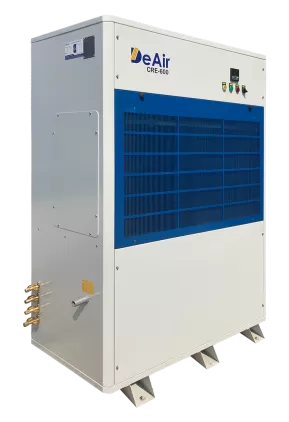
DeAir.CRE-600 isothermal dehumidifier suitable for laboratories
-
Heat-Pump Stainless Steel Dehumidifier DeAir.RE-H:
- Advantages: Features a stainless steel casing, increasing durability and suitability for environments requiring high hygiene or with corrosive properties commonly found in laboratories. Heat-Pump technology helps save energy.
- Capacity (depending on model): DeAir.RE-150H (150 kg/day), DeAir.RE-300H (300 kg/day), DeAir.RE-600H (600 kg/day).
- Applications: Suitable for medical - pharmaceutical laboratories, storage facilities, laboratories, or harsh environments. Also suitable for salt production, food and pharmaceutical processing, industries with high hygiene control requirements, dusty or high-temperature environments.
-

Heat Pump Dehumidifier DeAir.RE-300H INOX is suitable for use in laboratories due to its INOX casing, which is less affected by the environment
-
Heat-Pump Dehumidifier DeAir.RE (1 phase and 3 phase):
- Advantages: Suitable for various spaces, from residential to industrial, prioritizing dehumidification efficiency and energy saving. Heat-Pump technology reuses heat to reduce power consumption. Capable of stable operation even in low ambient temperatures and minimizes cooling of the surrounding environment.
- 1-phase capacity: DeAir.RE-60 (60 kg/day), DeAir.RE-100 (100 kg/day), DeAir.RE-150 (150 kg/day), DeAir.RE-300 (300 kg/day), DeAir.RE-600 (600 kg/day).
- 3-phase capacity: DeAir.RE-192 (192 kg/day), DeAir.RE-300 (300 kg/day), DeAir.RE-500 (500 kg/day), DeAir.RE-600 (600 kg/day), DeAir.RE-900 (900 kg/day), DeAir.RE-1200 (1200 kg/day).
-
- Advantages: Manufactured according to European standards with an R&D team with over 20 years of experience. Controls both absolute and relative humidity down to very low dew points for industrial applications. Lower investment and installation costs compared to combining air conditioners and dehumidifiers. Stepless airflow control by frequency converter helps save power and provides precise airflow.
- Capacity: Models from Dezenno-320 to Dezenno-18000 with dehumidification capacity from 1.4 kg/h to 134 kg/h (at 20°C/60%).
- Note: The Dezenno series is suitable for laboratories with very low humidity requirements (very low dew point) or specialized industrial applications.
Monitoring and Measurement of Temperature and Humidity in Laboratories
To comply with temperature and humidity regulations for laboratories, these parameters need to be thoroughly checked before and after experiments. Monitoring environmental conditions is a requirement of ISO 17025:2017.
Common temperature and humidity measuring devices include thermometers, hygrometers, and digital temperature and humidity meters (thermo-hygrometers). Digital devices combine both functions and often have additional features such as data logging, out-of-limit alarms, and computer connectivity.
Monitoring and recording humidity helps track changes and take timely control measures. The frequency of humidity monitoring depends on the specific requirements of each test and the stability of the environment, which can be continuous, daily, or periodic.
Yêu cầu đối với thiết bị theo dõi nhiệt độ và độ ẩm bao gồm:
- Must be calibrated before and during use.
- Output display must be easily accessible during operation.
- Previous data can be extracted for review.
- Recorded data can be stored for a specified period.
Furthermore, temperature and humidity must not only be recorded in the environmental monitoring log but also in the calibration report during the actual laboratory activity. This ensures that calibration is performed under acceptable environmental conditions and does not affect the validity of the results, while allowing the procedure to be repeated if necessary.
Why Choose DeAir for Laboratory Humidity Control Solutions?
DeAir is committed to providing comprehensive and optimal solutions, tailored to the specific needs of each customer. DeAir's expert team has extensive experience in laboratory humidity control.
DeAir engineers will conduct thorough surveys and advise on the most optimal solution. They support consulting on design, selection of the most suitable dehumidifier model for specific area, temperature, target humidity, and other special conditions of the laboratory. They also support integrating equipment into existing HVAC systems (if any).
DeAir is proud to offer professional, comprehensive technical services, built on a strict quality management system according to ISO 9001:2015 standards. After-sales service is a top priority, including providing technical services, installation, maintenance, spare parts supply, and repair for all types of dehumidifiers currently on the market.
To consult on selecting a suitable dehumidifier for laboratories, you can contact DeAir directly. You will need to provide additional information about the area/volume, type of goods/process, humidity/temperature requirements, and other special requirements.
- Phone: 0933 628 660 or 0925 977 579.
- Website: deair.com.vn.
Conclusion
Humidity control in laboratories is a key factor to ensure the accuracy, reliability, and integrity of test results, as well as equipment protection and personnel safety. Using a laboratory dehumidifier is an effective solution to maintain ideal environmental conditions. Specialized dehumidifier lines from DeAir, especially models using Heat-Pump technology or with corrosion-resistant casings, offer many suitable options for the stringent requirements of laboratory environments. For an optimal solution, please contact our experts for consultation based on the specific characteristics of your laboratory.
8 Frequently Asked Questions (FAQ) about temperature and humidity control in laboratories:
How do humidity and temperature affect experiment results and equipment in laboratories?
Humidity and temperature can significantly impact experiment results and equipment performance. Excessively high humidity can damage precision instruments, lead to inaccurate readings on measuring devices, affect the speed and efficiency of chemical reactions, and create conditions for mold and bacteria growth, leading to sample contamination. Low humidity can generate static electricity, harming electronic devices. Temperature also directly affects humidity (they are inversely proportional), and temperature changes can impact the sensitivity of load cells or deform the structure of materials and test samples. Maintaining stable temperature and humidity is crucial to ensure the accuracy and reliability of experiment results, protect equipment and materials, and create a comfortable working environment for personnel.
Which standards regulate temperature and humidity control in laboratories?
TCVN ISO/IEC 17025:2017 standard sets out general requirements for the competence of testing and calibration laboratories. Clause 6.3 of this standard stipulates that facilities and environmental conditions must be suitable for laboratory activities and not adversely affect the validity of the results. The laboratory needs to monitor, control, and record environmental conditions such as temperature and humidity according to relevant technical specifications, methods, or procedures, or when they affect the validity of the results. Specific temperature and humidity requirements may vary depending on the type of laboratory and equipment used, typically referenced from equipment manufacturers' guidelines, standard publications (such as ASTM or NIST), legal requirements, or accreditation body requirements.
What is the ideal temperature and humidity range in laboratories in general?
Although specific requirements may vary depending on the type of laboratory, a general guideline from the U.S. Food and Drug Administration (FDA) suggests that the optimal temperature for laboratories is 20°C to 25°C (68°F to 77°F) with humidity ranging from 30% to 50%. For length measurement laboratories, the ideal temperature is (20 ±2) °C and relative humidity (RH) is (40 ÷ 60) %RH. For electrical and electronics laboratories, the temperature is (23 ±5) °C and relative humidity (RH) is (40 ÷ 70) %RH. Maintaining relative humidity between 30% and 50% and temperature between 20°C and 25°C is considered most ideal for the general environment.
What methods and equipment are used to control temperature and humidity in laboratories?
To control humidity in laboratories, devices such as industrial air dehumidifiers are the primary solution. The selection of a dehumidifier needs to be based on the overall humidity load of the space, taking into account area, floor height, airtightness, moisture sources, and fresh air supply. In addition to conventional dehumidifiers, more specialized solutions include isothermal dehumidifiers capable of simultaneously controlling both humidity and temperature, or rotor dehumidifiers (rotor dehumidifiers) used when very low humidity (very low dew point) is required. For temperature control, precise air conditioning systems, chillers, air handling units (AHU), and various types of heat exchangers (such as finned tube heat exchangers, tube heat exchangers, micro-channel heat exchangers, air-to-air heat exchangers) are used.
Why is monitoring and recording temperature and humidity in laboratories important?
Monitoring and recording temperature and humidity are mandatory requirements according to ISO 17025:2017. This helps the laboratory track changes in environmental conditions, provide evidence of maintaining acceptable conditions, and take timely control measures when necessary. Data on temperature and humidity during calibration or testing must also be recorded in the report to ensure the validity and reproducibility of the results. Failure to strictly monitor and control can lead to errors in results, affect the laboratory's reputation, and even invalidate work if environmental conditions do not meet technical requirements.
What are the important considerations when choosing a dehumidifier for laboratories?
When choosing a dehumidifier for laboratories, it's not just about the area, but also about calculating based on the overall humidity load. Factors to consider include area, floor height, airtightness, moisture sources, and fresh air supply. Additionally, precise humidity control requirements (often below 50%RH), stable temperature control, low noise, continuous operation capability, corrosion-resistant materials (if needed), and energy efficiency are very important. Heat-Pump technology dehumidifiers can be a good choice for energy saving. For very low humidity requirements, a rotor dehumidifier is suitable.
Besides equipment, what other environmental control measures are there in laboratories?
In addition to using equipment such as dehumidifiers and air conditioning systems, other control measures include ventilation control to ensure air circulation and prevent moisture accumulation. Strict control over personnel entry and exit from the laboratory is also very important to maintain temperature and humidity stability. Limit opening windows in air-conditioned rooms and only allow qualified personnel to monitor and record environmental data. Proper cleaning and preservation of equipment, chemicals, and specimens also contribute to maintaining an ideal environment.
What humidity control solutions does DeAir offer suitable for laboratories?
DeAir is a company specializing in providing humidity control solutions, including dehumidifiers suitable for laboratories. Notable product lines mentioned include the DeAir.RE-CRE isothermal dehumidifier (floor-standing or ceiling-mounted) with the ability to simultaneously control both humidity and temperature, especially useful for temperature-sensitive experiments. DeAir also offers dehumidifiers using Heat-Pump technology to save energy. Additionally, the Dezenno Rotor dehumidifier is suitable for laboratories requiring very low humidity. DeAir provides consulting, design, installation, and maintenance services, helping customers choose the optimal solution based on the specific needs of each laboratory.
Sign up for news from DeAir
Related news






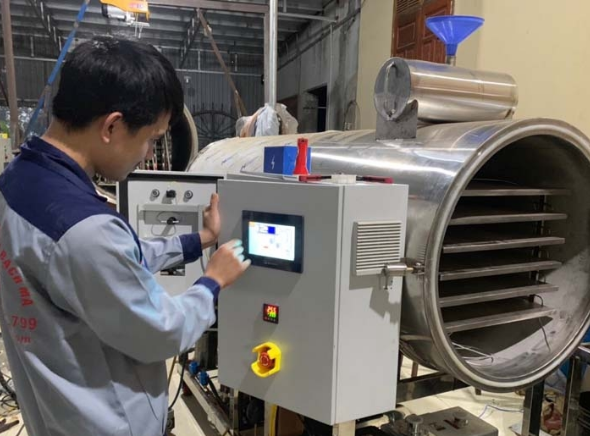



![[Case Study] DeAir Installs DeAir.De Rotor Humidity Control System for Pharmaceutical Plant in Binh Duong [Case Study] DeAir Installs DeAir.De Rotor Humidity Control System for Pharmaceutical Plant in Binh Duong](https://deair.com.vn/thumbs/news/2023_04/ban_giao_may_cho_duoc_bd/[270x153-cr]image1-1024x772.jpg__cv.webp)

![[Review & Guide] Olmas OS-300: The New Humidity Control "Warrior" for Medium to Large Warehouses [Review & Guide] Olmas OS-300: The New Humidity Control "Warrior" for Medium to Large Warehouses](https://deair.com.vn/thumbs/news/huong_dan_su_dung_may_olmas_21/[270x153-cr]vtm06440.png)